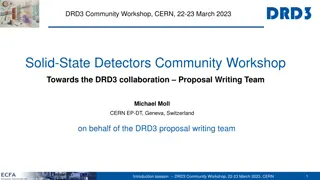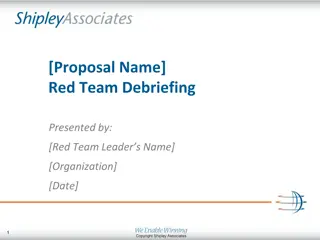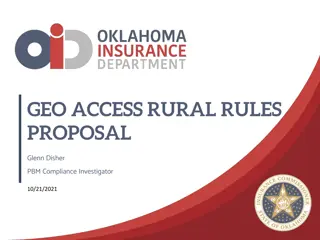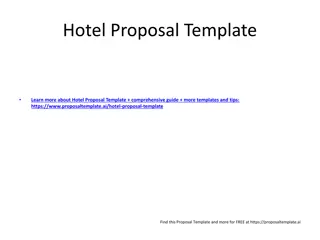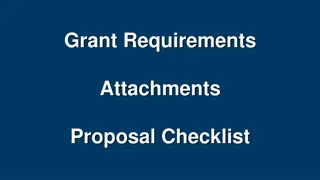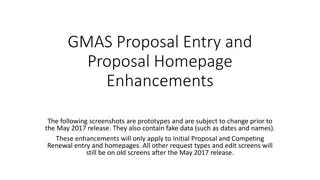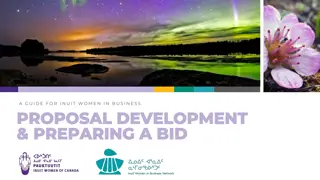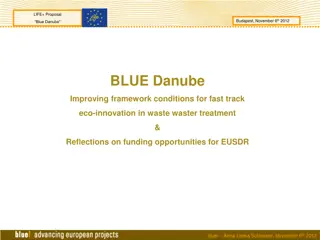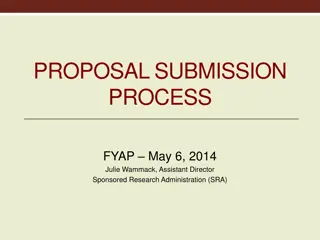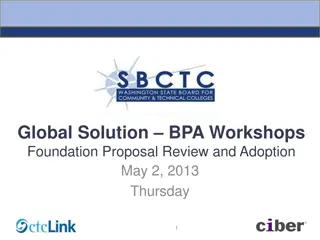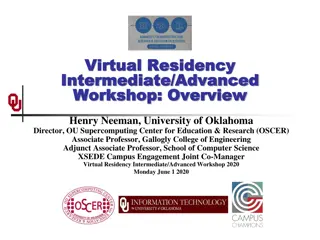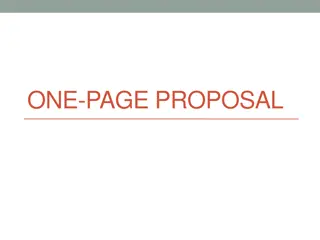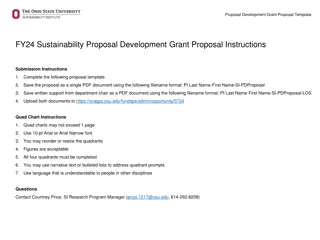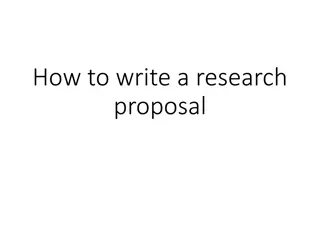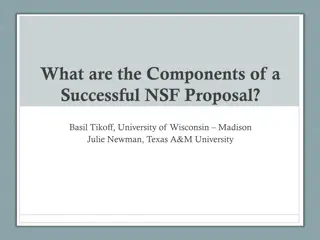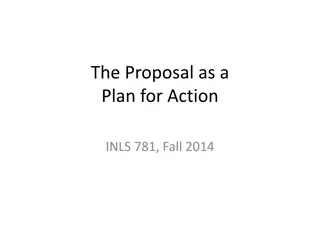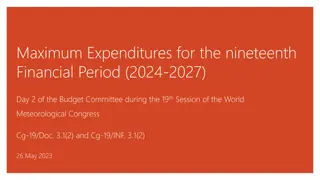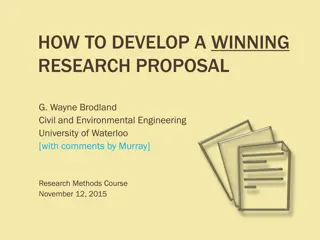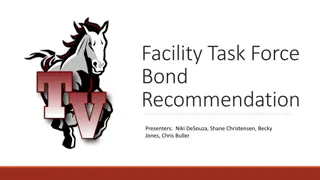
Undergraduate Research Programs and Opportunities at The University of Toledo
Explore undergraduate research programs at The University of Toledo, including summer research experiences, internships, and work-study programs. Learn about valuable characteristics for success in research and discover how to get involved in diverse research areas. Contact Dr. Jonathan Bossenbroek for more information.
Download Presentation

Please find below an Image/Link to download the presentation.
The content on the website is provided AS IS for your information and personal use only. It may not be sold, licensed, or shared on other websites without obtaining consent from the author. If you encounter any issues during the download, it is possible that the publisher has removed the file from their server.
You are allowed to download the files provided on this website for personal or commercial use, subject to the condition that they are used lawfully. All files are the property of their respective owners.
The content on the website is provided AS IS for your information and personal use only. It may not be sold, licensed, or shared on other websites without obtaining consent from the author.
E N D
Presentation Transcript
Office of Undergraduate Research Proposal Preparation Workshop Dr. Jonathan Bossenbroek Director - OUR January 29 2 The University of Toledo
Contact Information Dr. Jonathan Bossenbroek Director OUR undergraduate.research@utoledo.edu MacKinnon Hall 2000 419-530-2983 http://www.utoledo.edu/honors/undergradresearch/ 3
OURUT Research Programs Academic Year Research Program: AYRP First Year Summer Research Experience: FYSRE Research Travel Grant Program: Travel Undergraduate Summer Research & Creative Activity Program: USRCAP 4 The University of Toledo
OURUT Research Programs Academic Year Research Program: AYRP First Year Summer Research Experience: FYSRE Research Travel Grant Program: Travel Undergraduate Summer Research & Creative Activity Program: USRCAP UT-City of Toledo Internship Program: Toledo Talent Keeps Toledo Great (TTKTG) Work-Study Research Program: WSRP 5 The University of Toledo
USR&CAP and FYSRE The Undergraduate Summer Research and Creative Activity Program (USRCAP) and First Year Summer Research Experience: (FYSRE) are the main summer research programs and are open to all UT undergraduate students in all areas of research and/or creative activity at UT. These are competitive program that support research & scholarship by undergraduate students under the direction of a faculty member. 6
Undergraduate Research Top 8 Characteristics of success at Google (in order of importance) being a good coach communicating and listening well possessing insights into others (including others different values and points of view) having empathy toward and being supportive of one s colleagues being a good critical thinker and problem solver being able to make connections across complex ideas STEM expertise. 7
Undergraduate Research Top 8 Characteristics of success at Google being a good coach communicating and listening well possessing insights into others (including others different values and points of view) having empathy toward and being supportive of one s colleagues being a good critical thinker and problem solver being able to make connections across complex ideas STEM expertise. 8
Follow your passion What do you call a passion without a plan? 10
Follow your passion What do you call a passion without a plan? A HOBBY! 11
Follow your passion What do you call a passion with a plan? 12
Follow your passion What do you call a passion with a plan? Research and Scholarship 13
Steps to getting involved research and creative activities: Step 1: Find a mentor Step 2: Develop an idea Step 3: Develop a proposal Step 4: Apply for funding Step 5: Plan your project Step 6: Present your work 14
Step 1: Finding a mentor Talk to your professors Faculty members across campus are involved with research, scholarship and creative activities. Some faculty regularly have undergraduates as volunteers or paid technicians in their labs, which is a great place to start. 15
Step 2: Develop an idea Research and scholarship begin with ideas and questions. Your mentor can help you develop an idea. These ideas can be closely tied with the activities already being conducted by a faculty member or graduate student, or start a new direction for you and the faculty mentor. 16
Step 3: Develop a proposal A proposal lays the groundwork and defines the boundaries and scope of a project. Most importantly a proposal is the stage of research that forces clarity of the question and objectives and ensures that the means to address these issues is feasible in a timely manner. 17
Step 4: Apply for funding The Office of Undergraduate Research funds research and creative activities primarily focused on summer research. 18
Content Guidelines Project Description - 5 to 8 pages What you propose to do. How you propose to do it. Why it is important. Timeline Budget & Budget Justification Academic Statement - 1 to 2 pages Formatting See Template for Instructions 21
Project Description Two areas of the Project Description Intellectual Merit (Introduction, Objective/Hypotheses, Methods, Expected Results) Broader Community Impact 22
Project Description Focus on your Question, Objective, Goal or Hypothesis. There needs to be a focal idea that your proposal is built upon. Define this first! 23
Project Description Intellectual Merit (Introduction, Objective/Hypotheses, Methods) Focal Idea is the HEART of this Section It is the first thing you should think about. But doesn t come first in the proposal. 24
Project Description Intellectual Merit (Introduction, Objective/Hypotheses, Methods) Introduction background, literature review, or sources of inspiration. Explain the relationship of your project to your faculty mentor s research program Basically, the argument for why your Focal Idea is important Focal Idea is the HEART of this Section 25
Project Description Intellectual Merit (Introduction, Objective/Hypotheses, Methods) Your introduction should have background, literature review, or sources of inspiration. Focal Idea is the HEART of this Section Describe your methods How will you answer or address your idea/question? Written for those outside your discipline 26
Project Description Intellectual Merit (Introduction, Objective/Hypotheses, Methods) Your introduction should have background, literature review, or sources of inspiration. Focal Idea is the HEART of this Section Describe your methods Expected results Including how the project results will be disseminated 27
Project Description Intellectual Merit (Introduction, Objective/Hypotheses, Methods) Broader Community Impact How does this project have the potential to impact the community-at-large? This is your opportunity to explain the significance of the research to a layperson and should be free of jargon or overly technical language. 28
Project Description Intellectual Merit (Introduction, Objective/Hypotheses, Methods) Broader Community Impact References Style of references is your choice Proper citations are a necessary component to ETHICAL conduct of research. Not counted in the proposal page limit. 29
Content Guidelines Project Description - 5 to 8 pages What you propose to do. How you propose to do it. Why it is important. Timeline Budget & Budget Justification Academic Statement - 1 to 2 pages 30
Timeline Describe the various steps or milestones you plan on taking to work on your project. For a summer project, describe how you perceive the project will progress during the ten weeks. Research and scholarship often diverge from an expected path, but planning a timeline helps you in making progress on your project. Helps the reviewers judge if the work is achievable in the allotted time. 31
Budget 32
Example: 33
Budget Justification Clearly state why the budget items are being requested and needed for the project to be successful. 34
Academic Statement Why you are eager to spend ten weeks of your life conducting *THIS* project Explain how what you propose to do will fit into your professional career aspirations. Not just because it will add a line to your resume! 35
Writing Advice Write in your own voice! Be clear about your Focal Idea, Question, Objective, etc. The rest of the proposal hinges on this idea! Clearly describe: What you propose to do. How you propose to do it. Why it is important. 36
Writing Advice Have other students and your mentor review your proposal. Edit, edit, edit! (did I say edit?) MEET the DEADLINE! 37
Proposal Evaluation Intellectual merit (35%) Broader Impact (10%) Academic Statement (15%) Articulation/Description of the project (30%) Faculty support letter (10%) 38
Proposal Evaluation Intellectual merit (35%) - The intellectual merit of the project should be evaluated on two primary factors: 1) The rationale for the project should be founded in the literature or a clear description of the inspiration or connection to scholarly work. The rationale should also contain a clear description of how this work is related to the mentor s research program. 2) The result of the project should be of high quality with the potential to be a manuscript, conference presentation, performance, or exhibition. 5 The rationale and potential for a high quality result are both strong. 4 Either the rationale or potential result is not of a quality expected for publication or exhibition without additional work. 3 The rationale has limited connection to recent scholarship and/or the potential result is likely to only make a limited contribution to the field. 2 The rationale is inconsistent or contains errors and/or the results are likely to have little potential to make a tangible contribution to the field. 1 The rationale contains serious errors and the results are likely to have little/no potential to make any contribution to the field. 39
Proposal Evaluation Broader community impact (10%) - The student should clearly state how this project has the potential to impact the community-at-large. 5 Has potential to make a substantial contribution to the community- at-large. 4 Has potential to make a contribution to the community-at-large. 3 Has potential to make a limited contribution to the community-at- large. 2 Has little potential to make a contribution to the community-at-large or contains errors. 1 Has very little/no potential to make any contribution to the community-at-large or contains serious errors. 40
Proposal Evaluation Academic and professional development (15%) - The student should describe why they are interested in the project and the value of the project to their academic and professional development. 5 Student provides an excellent description of their interest in the project and why it will fit into the student s career aspirations and their academic program. 4 Student provides a good description of their interest in the project and why it will fit into the student s career aspirations and their academic program. 3 Student provides a satisfactory description of their interest in the project and why it will fit into the student s career aspirations and their academic program. 2 Student provides a poor description of their interest in the project and why it will fit into the student s career aspirations and their academic program. 1 Student provides an unacceptable description of their interest in the project and why it will fit into the student s career aspirations and their academic program. 41
Proposal Evaluation Articulation/Description of the project (30%) - The proposal and academic statement should be written in a manner that is easily understood to persons both within and outside of the field of research. Proposals that give the impression that they were written by their faculty mentor or heavily copied from existing theses, grants or publications, without much effort by the submitter, will be rated LOW. 5 Project and statement are easily understood to persons both within and outside of the field. 4 Project and statement are understood to persons both within and outside of the field with some effort. 3 Project and statement are written for persons within the field but difficult for persons outside the field to comprehend. 2 Project and statement are difficult to understand for persons both inside and outside the field. 1 Project and statement are nebulous and/or difficult to understand for persons both inside and outside the field. 42
Proposal Evaluation Faculty support letter (10%) - The faculty mentor should assess the student s abilities to perform the project as described in the proposal and clarify how the proposed work aligns with their scholarly work. 5 Faculty support letter describes the student s ability to perform the project in the proposed time frame as excellent. 4 Faculty support letter describes the student s ability to perform the project as above average. 3 Faculty support letter describes the student s ability to perform the project as sufficient. 2 Faculty support letter describes the student s ability to perform the project as minimal. 1 Faculty support letter describes the student s ability to perform the project as poor. 43
Dates for summer proposals End of January - Proposal Workshops 3rd Tuesday of February - Proposals due! 3rd Tuesday of February Letters due! April Offers of Acceptance sent out. April - Paperwork May/June/July Conduct project At times, an extension will be granted for proposals. Be on the lookout! 44
Steps to getting involved research: Step 1: Find a mentor Step 2: Develop an idea Step 3: Develop a proposal Step 4: Apply for funding Step 5: Plan your project Step 6: Present your work 45
Step 5: Plan your project When your project gets funded create a research plan that can be accomplished in the time frame of the grant. Part of this should be complete through the proposal process. 46
Step 6: Present your work Late November Scholar s Celebration Hosted by Carlson Library NW Ohio Undergraduate Research Symposium 2021 - ?? Anytime OUR-UT helps support travel to present at conferences 47
Here to help! Contact Information Dr. Jonathan Bossenbroek Director OUR undergraduate.research@utoledo.edu MacKinnon Hall 2000 419-530-2983 http://www.utoledo.edu/honors/undergradresearch/ 48



